The Balsam fir has a conical shape, a strong, spicy aroma, and dark green needle-shaped leaves. Another common Christmas tree is the Fraser fir, which has soft leaves, grows to a medium height, and can easily support different types of decorations.

Selecting a Christmas tree is one of the first things many people do with the onset of the Christmas and holiday season. But with so many different types of Christmas trees available, this process can be quite complicated. You can easily get confused between the various species of fir, spruce, cypress, and other trees.
That’s why I’ve put together this guide on the subject to help you out.
1. Balsam Fir (Abies balsamea)
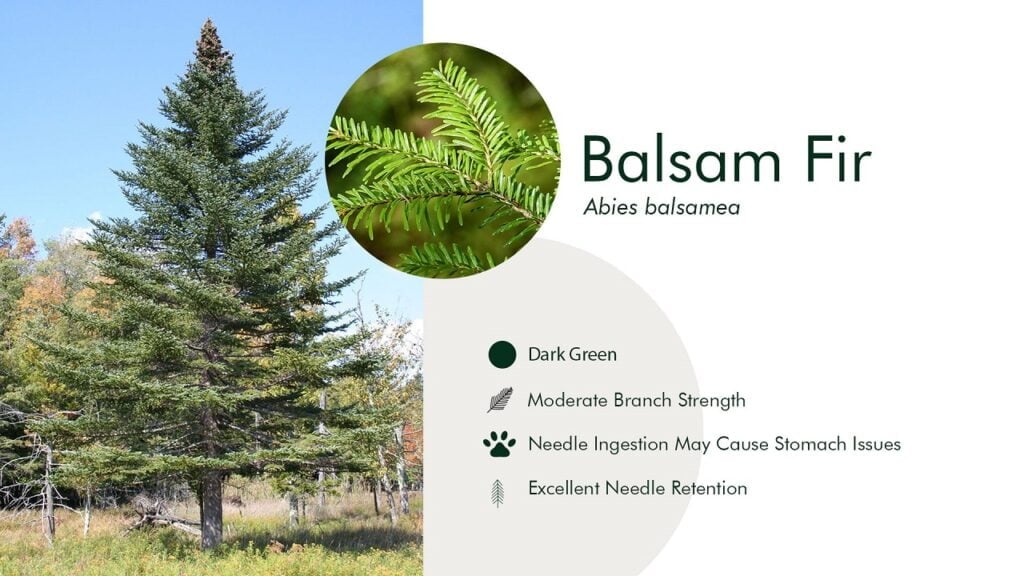
The Balsam Fir, commonly found in the northernmost parts of the United States, is an evergreen tree with a straightforward conical shape and dark green needle-like leaves. It's known for its robust scent and excellent needle retention. However, it's important to note that these soft needles can cause stomach issues if consumed by pets.
This tree, which can reach up to 66 feet in height, is often used as a moderate-sized Christmas tree. Although its branches are not very strong, they can still hold decorations. Typically grown in Canada and brought to the US during the holidays, this type of tree adds a simple yet festive touch to the season.
The balsam fir not only enhances the holiday spirit but also plays a vital role in supporting local wildlife. For those interested in how various tree species contribute to natural habitats, delve deeper with ‘nature and wildlife trees.’
2. Fraser Fir (Abies fraseri)
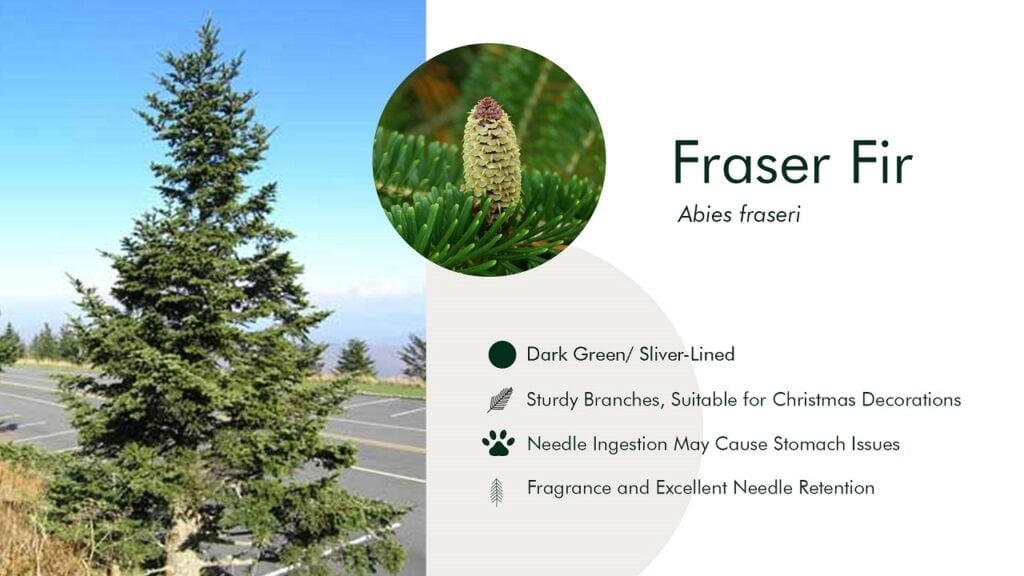
The Fraser Fir, distinguishable by its dark green, silver-lined color, is among the top choices for Christmas trees due to its exceptional suitability for decorations. It's sturdy enough to host various ornaments on its upward-growing, stiff branches that still bear soft, needle-like leaves. However, pet owners should exercise caution as just like the Balsam Fir, their consumption can cause stomach issues in pets.
This tree's triangle-like shape adds to its overall appeal, looking good from every angle, and it can reach a height of up to 50 feet. Additionally, Fraser Fir is well-known for its distinctive fragrance and excellent needle retention, qualities that, when combined with proper maintenance, make the tree's scent last longer, enhancing the festive atmosphere in the house.
3. Noble Fir (Abies procera)
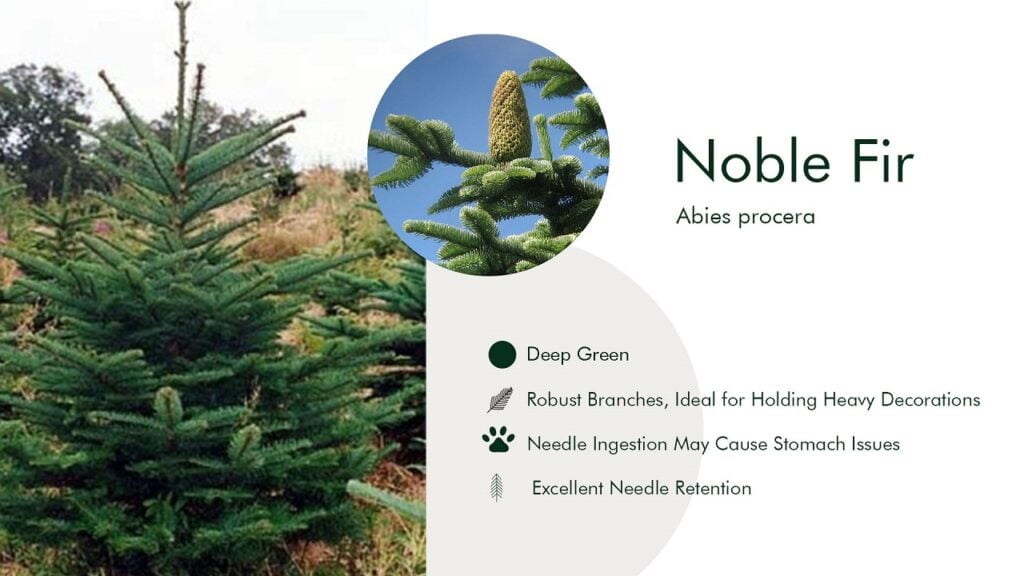
The Noble Fir, one of the most grandiose Christmas trees, has an impressive height potential of up to 260 ft., exhibiting a deep green color. Its exceptionally dense branches with blue-green needle-like leaves grow in bracts, offering a uniquely lush look. Just like with the Fraser Fir, pet owners should remain cautious of any potential needle consumption that could cause stomach issues in pets.
The branches of the Noble Fir, native to the Pacific Northwest, are sturdy yet flexible, making them an ideal choice for creating fresh holiday wreaths, or even for holding up heavier decorations on the tree itself. They have an upward curve, facilitating the attachment of ornaments. Noticed for robust branches and excellent needle retention, this tree also carries a strong fragrance, which makes it a coveted choice for adding a merry touch to holiday decorations.
The Noble Fir is renowned for its robust branches and captivating fragrance, making it a popular choice for those looking to theme their holiday decorations. Discover a variety of decorating themes including the Noble Fir by exploring 'themed Christmas tree ideas.'
4. Grand Fir (Abies grandis)
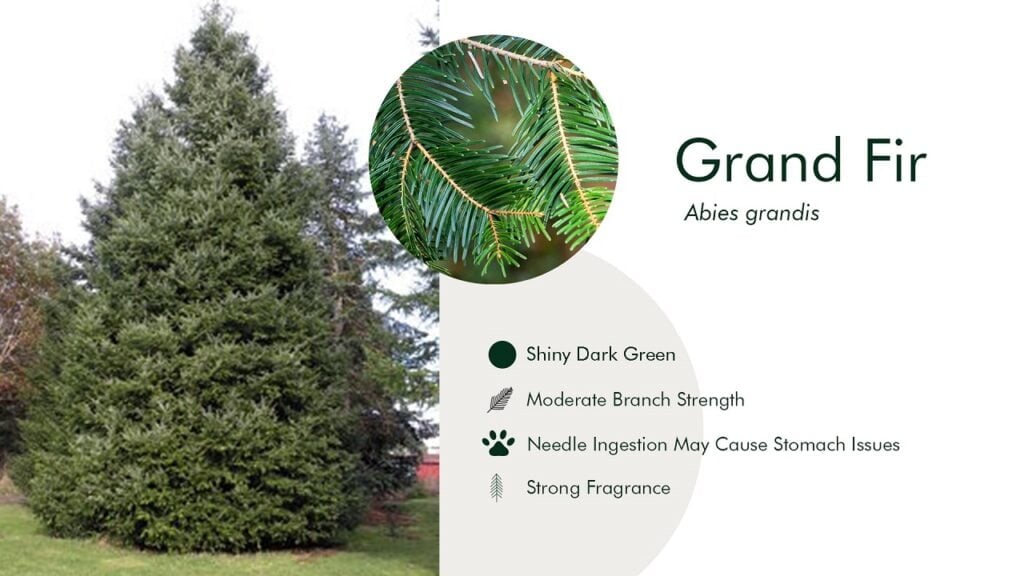
The Grand Fir, a distinct Christmas tree variety, towers over many others with its potential to grow up to 300 ft. Discovered in areas like Northern California and the regions close to the Pacific Ocean, it stands out with its glossy, shiny dark green needles organized in two neat rows, each featuring a unique white stripe with a yellow-green hue. Just like the others, keep an eye out for pets as the needles may upset their stomachs if consumed.
Its bark dons a grayish-brown color, and the tree is well-reputed for its dense foliage and unique fragrance blend. This scent, stronger than most but still pleasing to the senses, carries a slight hint of citrus, layered on top of the traditional spicy Christmas aroma. The Grand Fir, traditionally used to freshen up interiors by bringing its boughs inside, features moderate branch strength which supports decorations nicely, maintaining a balanced appeal in festive décor.
5. Arizona Cypress (Cupressus arizonica)
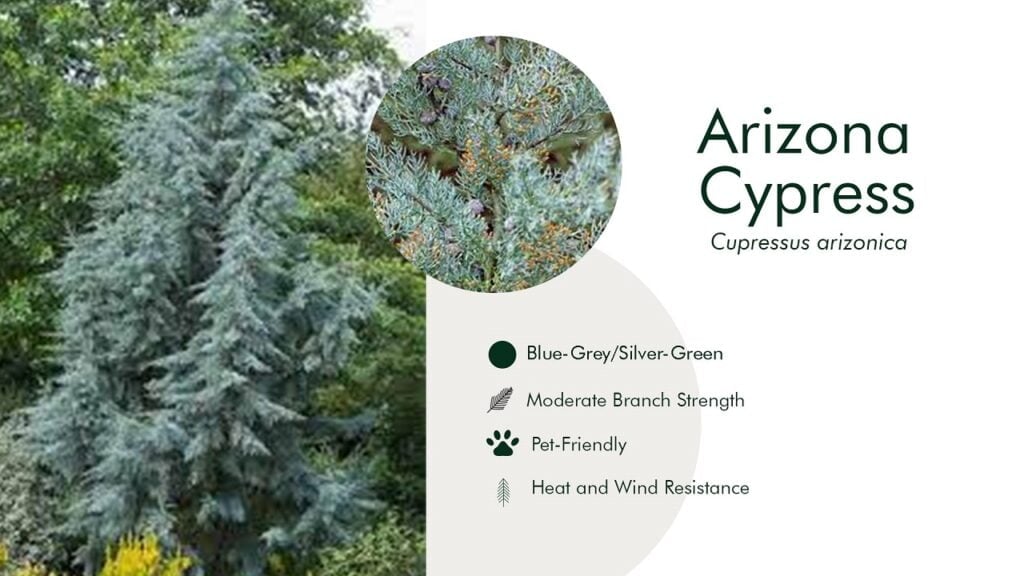
The Arizona Cypress, native to northern Mexico and the southwestern United States, is a unique Christmas tree variety with its distinctive blue-grey/silver-green color. This pyramid-shaped, evergreen tree offers an appealing combination of drought, heat, and wind resistance, making it a robust choice for the holiday season. It can grow up to 60 feet, marking it as an ideal mid-sized option, further standing apart from other trees for being pet-friendly.
Beyond just holiday festivities, the Arizona Cypress offers pragmatic benefits such as erosion control and acting as a windbreak. With its moderate branch strength, it handles the weight of decorations and Christmas ornaments well, further solidifying its position as a preferred choice for a Christmas tree.
6. Colorado Blue Spruce (Picea pungens)
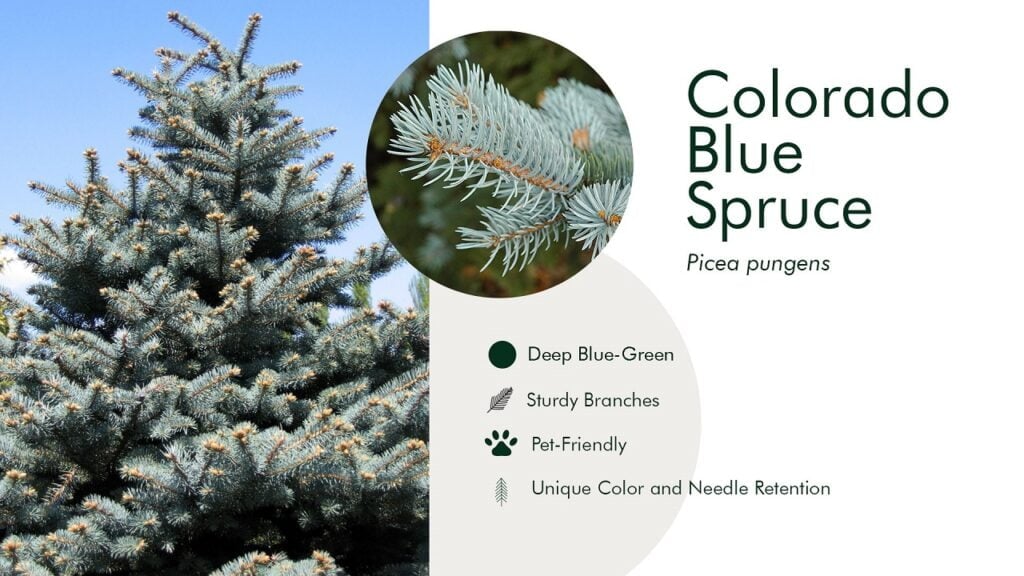
The Blue Spruce, bearing a deep blue-green color that sets it apart from other Christmas tree species, spotlights a unique silvery-blue shade in its leaves. Originating near the Rocky Mountains and being the state tree of Colorado, this species is often known as the Colorado Blue Spruce. It can grow up to 75 feet, providing a grand backdrop for the holiday season with its sturdy branches renowned for their capacity to bear heavy ornaments. It's also pet-friendly as the sharp needles tend to deter curious pets from approaching the decorations.
Although the Blue Spruce's sharp leaves lend the tree a unique aura, they might make it a less suitable choice for homes with young children. Therefore, it's recommended to wear long sleeves and gloves during its decoration. However, its distinct color and excellent needle retention more than compensate for this little inconvenience, making it a notable addition to the realm of Christmas trees.
7. Leyland Cypress (Cupressus x leylandii)
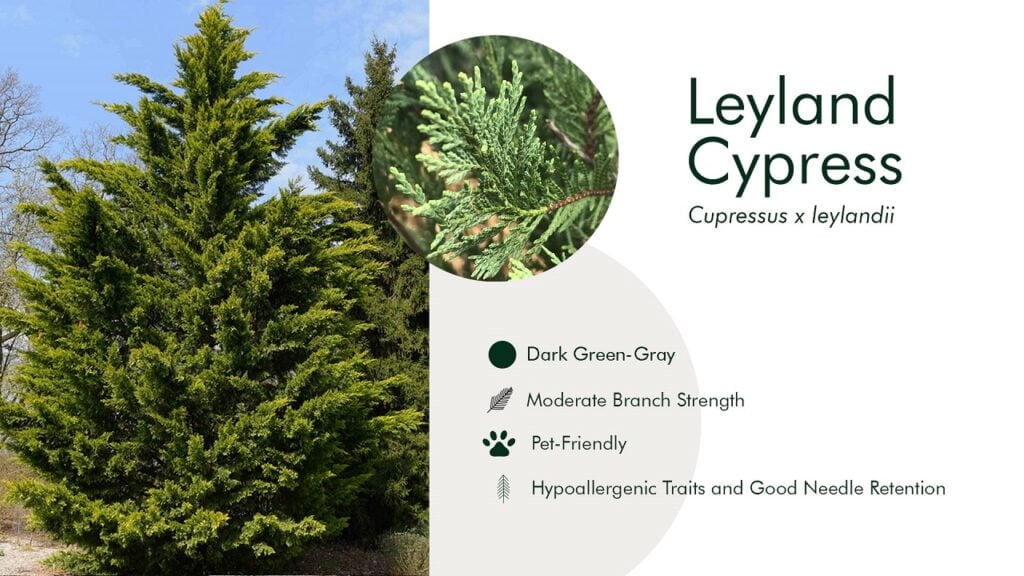
The Leyland Cypress, savored for its dark green-gray color, is an acclaimed Christmas tree choice, particularly in the southeast US. Often utilized for creating fences and hedges, this tree's potential height of up to 60 feet offers a versatile choice for holiday décor. Its soft grayish-green leaves are scent-free and don't produce any sap or pollen, making this tree perfect for those with pollen allergies, contributing to its reputation as a pet-friendly option.
Exhibiting a pyramidal shape due to the upward-growing leaves, this tree brings a unique aesthetic appearance. Moreover, the Leyland Cypress is one of the fastest-growing Christmas trees and is praised for its good needle retention, experiencing very few leaf falls throughout the festive season. All these features make it an advantageous and popular choice for Christmas celebrations.
8. White Fir (Abies concolor)
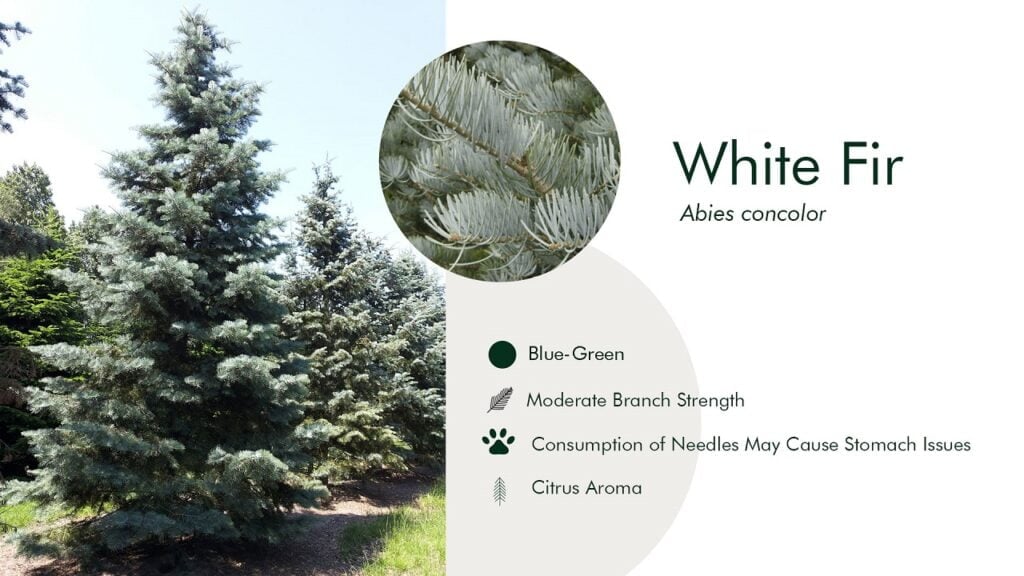
The White Fir tree, often called the Concolor Fir, boasts a striking blue-green color with flattened, pointed-tip leaves that curve upwards, lending it a conical shape. This hardy Christmas tree species can soar up to an impressive 195 ft, but pet owners should be wary as its consumption can potentially cause stomach issues in pets.
What truly sets the White Fir apart is its unique aroma. When the silvery blue/green leaves are crushed, they release a captivating citrus-like scent, making it a wonderful option for those that enjoy a fragrant tree. With moderate branch strength suitable for supporting decorations and outstanding needle retention resulting in very few leaves falling off throughout the season, this tree adds a carefree, aromatic touch to the holiday festivities.
9. Douglas Fir (Pseudotsuga menziesii)

A commonly seen option on farms, the Douglas Fir is a tremendously popular Christmas tree choice. It boasts shiny, soft leaves in a dark green-blue color, growing in dense clusters. These leaves, cautionary for pet owners due to potential stomach issues if consumed, produce a sweet scent and grow in all directions, giving this tree its pyramidal form. Despite being typically medium-sized, Douglas Firs can reach astounding heights of up to 330 ft.
Douglas Firs require ample water to maintain their well-liked features, without which their leaves might fall off. Even though their lifespan doesn't compare to many other Christmas tree types, their fragrance and good needle retention still make them a favorite. So, to ensure the Douglas Fir remains vivacious throughout the holiday season, it's recommended to get a freshly cut tree for display.
10. Canaan Fir (Abies balsamea var. Phanerolepis)
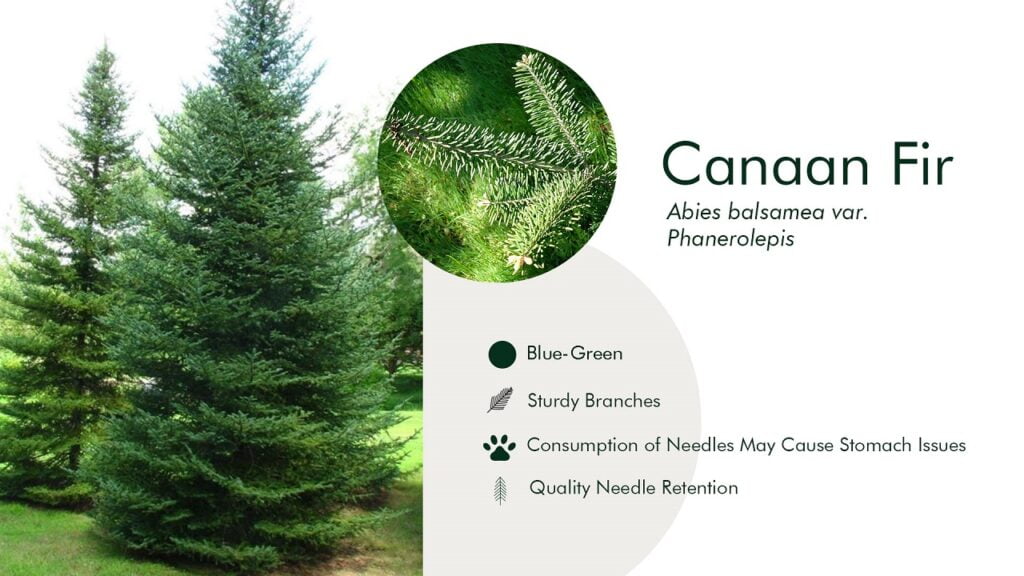
The Canaan Fir, featuring a lovely shade of blue-green, shares similarities with both the Balsam and Fraser Firs, especially in its pyramid-like structure and upward-growing needles. However, it outperforms Balsam Fir in needle retention, matching Fraser Fir for that quality trait. Be cautious with pets around this tree though, as the consumption of needles could cause stomach issues.
Its flat, darker green leaves and medium-height growth contribute to its elegantly simple look, perfectly complemented by sturdy branches ideal for Christmas decorations. Commonly found in the mountains of West Virginia, the Canaan Fir may be one of the newer Christmas tree types, but its popularity is soaring thanks to its outstanding needle retention and accessible elegance.
11. Eastern White Pine (Pinus strobus)
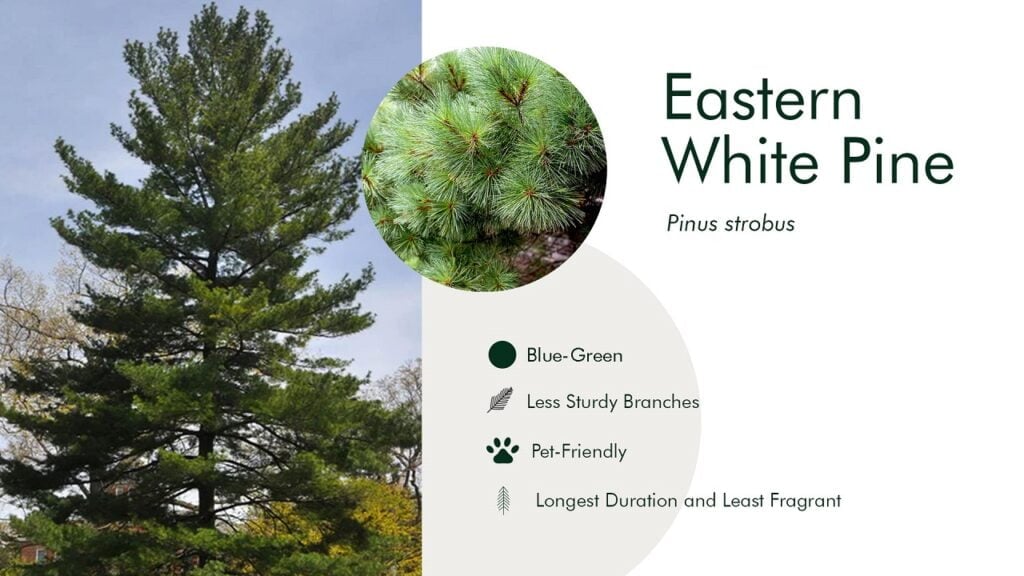
The Eastern White Pine, distinguishably characterized by its long, thin, needle-like leaves in clusters, projects an enchanting shade of blue-green. Its pointed tips can grow up to five inches in length, while remarkably, the leaves carry no aroma, making this a great Christmas tree choice for those with scent sensitivities. The Eastern White Pine is pet-friendly and holds its needles for the longest duration of all, even though it is the least fragrant.
While its branches are less sturdy, rendering them less suitable for heavy decorations, these branches are nevertheless utilized in creating centerpieces, wreaths, garlands, and more. Interestingly, the Eastern White Pine is the largest of all pine trees in the US, demonstrating a potential to grow up to an impressive 230 ft.
12. Norway Spruce (Picea abies)
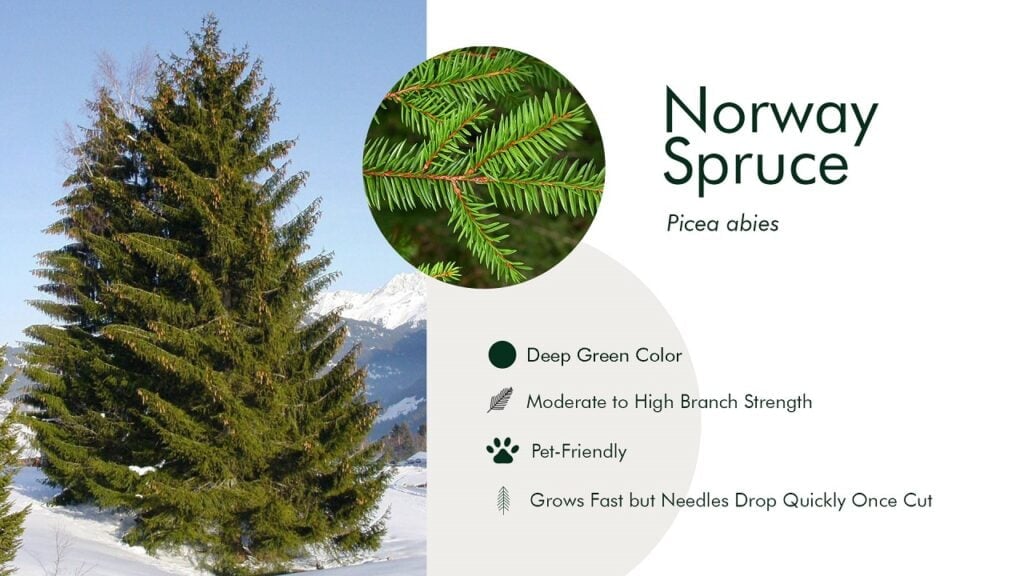
Boasting a rich, deep green color, the Norway Spruce, originally from Europe, carries a long history of being used for decorative purposes since the 16th Century in Germany, earning it the loving nickname of 'holiday spruce'. Each of its leaves sports a needle shape with pointed tips, contributing to its traditional Christmas tree look. Pet-friendly and with moderate to high branch strength, they can grow impressively tall, reaching a height of up to 180 ft.
Despite its rapid growth, Norway Spruces' needles tend to drop quickly once cut, so it's advisable to get this tree just a week before Christmas to enjoy it at its best. The popularity of this tree was affirmed when it was chosen to decorate the iconic Rockefeller Center in New York City for Christmas in 2020.
13. White Spruce (Picea glauca)
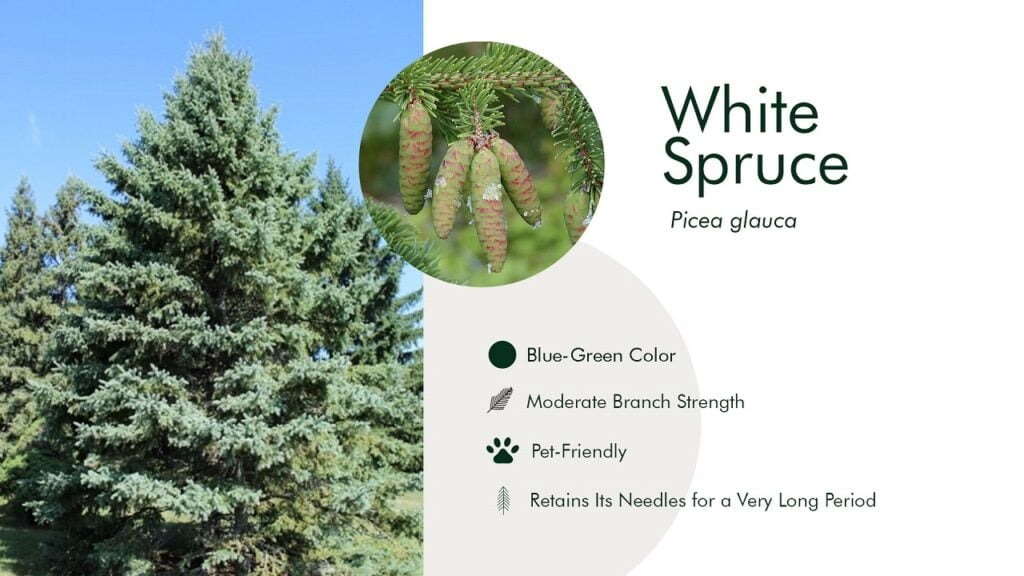
The White Spruce, radiating a pleasing blue-green color, is wonderfully suited for showcasing decorations and Christmas lights, owing to its moderate but sturdy branch strength. Recognized by various names, such as the Canadian Spruce, Western White Spruce, and Skunk Spruce, this tree is a popular pet-friendly Christmas tree option.
Hailing from the northern parts of the US, the White Spruce closely resembles the Colorado Blue Spruce, with short, needle-shaped leaves. However, it differs significantly in its scent, as its leaves release an unpleasant odor when crushed. Despite this, the tree is lauded for its superior needle retention, making it an excellent, vibrant choice for a festive display that endures throughout the holiday season.
14. Scotch Pine (Pinus sylvestris L)
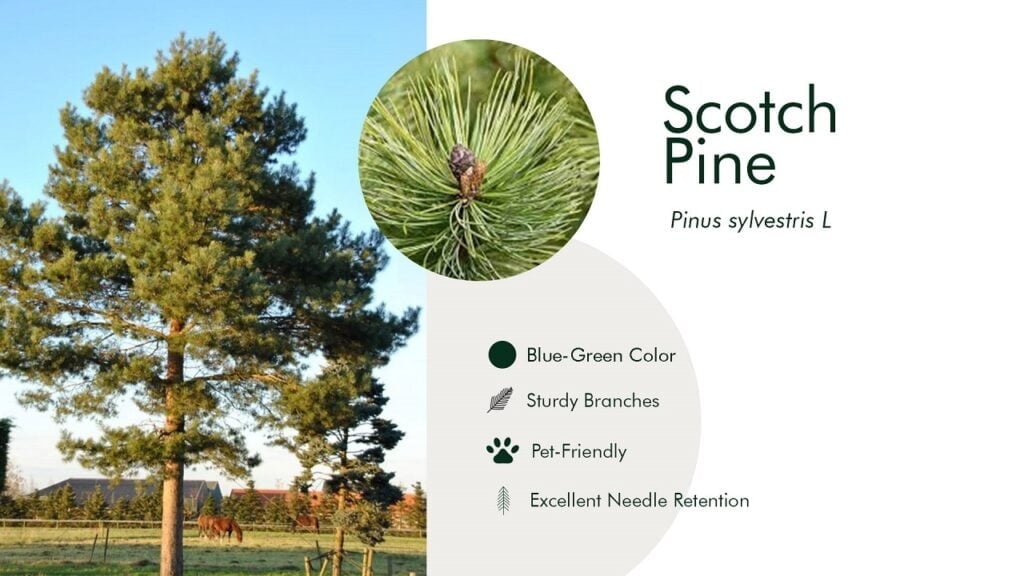
The Scotch Pine, characterized by its stunning blue-green color, first rose to Christmas tree fame in Great Britain and holds multiple monikers, including Scots Fir and Scots Pine. With its robust, dark green leaves encircling the central branch, and its red bark providing a standout contrast, this pet-friendly tree is aesthetically pleasing and great for hosting Christmas decorations, thanks to its sturdy branches.
Despite its leaves being sharp, making it advisable to use gloves during decorating, the Scotch Pine is still a preferred choice. Notable for its excellent needle retention, it emits a pleasant fragrance that lasts for a long duration and can soar up to a mighty 115 ft. in height. As an easy-to-maintain Christmas tree, and being the national tree of Scotland, the Scotch Pine is a deeply cherished choice for festive decorations.
15. Virginia Pine (Pinus virginiana)
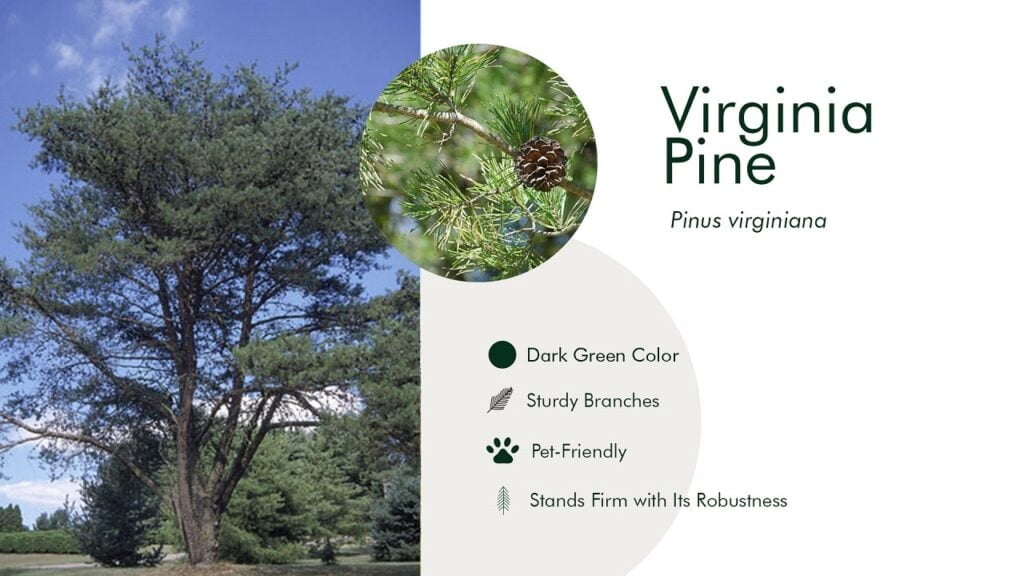
The Virginia Pine, displaying a lush, dark green color, is easily recognizable by its pairs of twisted and short leaves. Its dense foliage, which can be simply trimmed to achieve the perfect Christmas tree shape, is both pet-friendly and visually distinctive. This tree offers a modestly sized Christmas tree option, as it can grow up to 70 ft. tall.
One of the key highlights of the Virginia Pine is its low branches that facilitate easy decorating, perfectly suited to host heavy decorations thanks to the sturdy branches. It also has a robust nature that allows it to stand firm. Its needles stay on the tree for an extended time, reducing the need for frequent cleaning, thereby making it a convenient and attractive choice for Christmas decorations.
16. Red Cedar (Juniperus virginiana)

The Red Cedar, often referred to as the Eastern Red Cedar is a Christmas tree variety recognized by its rich, dark green color. Its branches grow closely together, providing thick and lush foliage. The leaves of this tree grow straight upwards, creating an appealing pyramidal form—a feature complemented by its dark and shiny green quality. Typically, a Red Cedar can grow over 40 ft tall. It's a favorite Christmas tree in areas such as Arkansas, Oklahoma, and Missouri, not only for its aesthetic appeal but also for its pet-friendly nature and moderate branch strength.
Contrary to its name, the Red Cedar is part of the Juniper family and not a cedar tree. Its namesake, however, stems from its beautiful Red Wood and pleasant aroma, earning it the alternate nickname of Aromatic Cedar. Coupled with its reputation for rapid growth, the Red Cedar makes for a remarkable and sweet-smelling addition to the holiday décor.
17. Korean Fir (Abies koreana)

The Korean Fir, a relatively new contender in the realm of Christmas trees, certainly adds an exotic touch to holiday festivities. Its leaves display a unique dual tone, with a dark green color on top and a captivating silvery hue underneath, resulting in a visually appealing contrast. This multicolored display, coupled with a classic pyramid shape and the ability to grow up to 50 ft tall, makes the Korean Fir stand out among its peers. While the consumption of needles may cause stomach issues in pets, the tree's sturdy branches make it suitable for hanging decorations.
But perhaps the most striking feature of this tree is its purple cones, a distinctive trait among Christmas trees. Another appealing factor is its high resistance to heat, representing a practical advantage over other fir trees and making maintenance comparatively easier. This blend of beauty and resilience makes the Korean Fir an exceptional Christmas tree option.
Do Christmas trees need a lot of sunlight?
For Christmas trees to thrive well, bright natural light and cool temperatures are most important. So, when you bring your Christmas tree indoors, make sure to keep it in a spot that receives plenty of sunlight but is away from any heat vents and fireplaces. Ideally, I would suggest bringing the tree in for a maximum of ten days at a time.
Alternatively, try keeping the Christmas tree near the doorway for a few days to help it recharge after it has spent some time in the limited light indoors. And when keeping the tree indoors, use a humidifier to make sure the air is moist and, if possible, lower the temperature.
How long does a Christmas tree last?
A Christmas tree that is watered regularly and well-maintained can last for around four to five weeks. After that period, it will start drying out. One easy way to know whether the tree is in good condition is to check whether the leaves or needles are falling off. Or see if the branches bow down when decorations are attached.
If you notice the leaves falling off, it may indicate that the tree is not getting enough water and is drying. Similarly, a Christmas tree that cannot support the weight of various decorations and ornaments may not be in good health. Finally, what species the tree belongs to can also affect how long it lasts.
Which type of Christmas tree has the best fragrance?
The Balsam fir (Abies balsamea) is often said to have the best-smelling fragrance among all types of Christmas trees. It has a warm, rich, sweet-smelling scent with woody undertones, generally associated with freshly harvested conifer trees.
Because of this pleasing aroma, balsam tree sap is often used in the perfume industry. Other types of Christmas trees known for their aroma include the grand fir, noble fir, scotch pine, and white fir. Many of these have a citrus-like scent that is slightly spicy and can bring freshness into your home.
Where did the tradition of decorating Christmas trees begin?
According to most sources, the tradition of decorating Christmas trees started in Germany in the 16th Century. Christians brought trees into their homes and decorated them with sweets, candies, pastries, flowers, apples, gingerbread, etc. Tin figures and glass baubles were also used for decorating Christmas trees.
Some Christians built wooden pyramids and decorated them using candles and other items when trees were not as easily available.
Do Christmas trees need a lot of water?
The amount of water required by a Christmas tree will depend on what type of tree it is. Some Christmas tree species, such as the Arizona cypress and Korean fir, are heat and drought-resistant and do not require much water. On the other hand, several species require a lot of water and can die quickly if they are not watered regularly.
In most cases, I would advise watering the Christmas tree daily, at least for the first eight to ten days after it is brought in. For a standard-size Christmas tree with a trunk diameter of five inches, you need to make sure it has at least five quarts of water at all times.
It is also a good idea to ask the seller about additional water requirements for the type of Christmas tree you plan to get.
Tip
When bringing your Christmas tree indoors, cut across the base of the tree trunk that is one inch in length. Then, place it in the stand with water. Doing so will help you eliminate any resin and help the tree absorb water more effectively.
Decorating Christmas trees is an important tradition that goes as far back as the 16th Century. And putting up trees during the holiday season is something almost everyone looks forward to every year. However, selecting the right type of Christmas tree is crucial for practical and aesthetic reasons.
With the appropriate Christmas tree, you will find it easier to put up decorations and require less effort to keep the tree in good condition. Since such trees will be easier to decorate with ornaments and objects without bowing under their weight, they will look much more attractive.
Just make sure to provide your Christmas tree with enough light and water so that it lasts throughout the holiday season.
